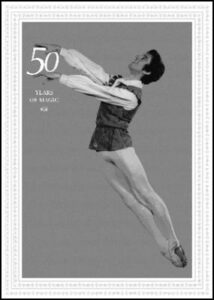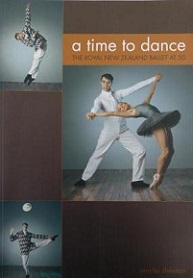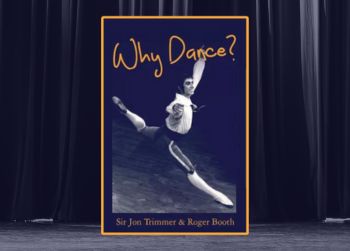Sir Jon Trimmer who died on 26 October 2023, was a figure who has been almost synonymous with the Royal New Zealand Ballet for decades. During a professional career that spanned nearly sixty years, Trimmer illuminated stages the length and breadth of the country; his performances in a wide variety of classical, contemporary, and character roles were always unforgettable. His MBE for services to ballet in 1974, and his knighthood in the Queen’s Birthday Honours List in 1999, recognised these achievements. While some dancers may have attracted more star-studded international glory, few can claim such longevity, or be held in such deep affection, as Trimmer. This blog offers a tribute to a great dancer and true man of the theatre who was also a good friend to Wellington City Libraries: when sharing his Stories from the Ballet with our branches he not only brought to life the plots and characters of several ballets, but he also introduced the audience to the significance of gesture and mime as the means of storytelling. Because of his inimitable ability to educate and entertain any age group, Trimmer’s Stories from the Ballet are still remembered vividly by library staff and their children and grandchildren.

Jon Trimmer grew up in Petone. He was one of six siblings in a creative family, actively involved in music and dance, but he only began formal ballet training at age 12. Showing a remarkable alacrity for the art form, he was asked to join the still-fledgling New Zealand Ballet Company in 1958 and benefitted from the rigorous regime imposed by its visionary director, Poul Gnatt. Trimmer’s early years with the Company prepared him to travel to London and study at the Royal Ballet School, from which he launched his international career. Despite Trimmer’s immediate success, he still missed Wellington and the New Zealand Ballet Company; he returned to New Zealand, and married Jacqui Oswald — who had joined the New Zealand Ballet Company on the same day as Trimmer in 1958 — before heading back overseas. Trimmer danced with the Sadler’s Wells Ballet, the Australian Ballet, the Royal Danish Ballet, and American Ballet Theatre, touring and performing alongside some extremely big names, but always feeling pulled homeward. When the New Zealand Ballet Company was foundering on the brink of disaster in the 1970s, the Trimmers broke their contract with the Washington DC Ballet to return home. They became irreplaceable mainstays of the Company (from 1984 the Royal New Zealand Ballet) through its crises and triumphs, as they discuss in the 2003 documentary 50 Years On Their Toes. Trimmer recalled when he and Jacqui Trimmer broke their contracts with the Washington DC Ballet to return to New Zealand and help rescue the New Zealand Ballet Company from collapse:
Instead of earning several hundred dollars a week, we were earning $75 but we managed to keep the company going …. if we had stayed overseas the company may not have continued. I might be being big-headed here. I would have hated that. It’s been in our blood and it would be terrible to see it dropped.”

Some fortunate readers will remember Trimmer performing danseur noble and virtuosic roles in the great ballets of the classical tradition: the Princes in The Sleeping Beauty, and The Nutcracker, Albrecht in Giselle, and Siegfried in Swan Lake. To all these roles he brought effortless technique, unique characterisation, and physical eloquence. In 1967 he performed the virtuosic role of Basilio in Don Quixote (forty years later, took on the titular role of the eccentric Spanish knight in a new production of the ballet). Trimmer made an effortless transition to the character roles in which he commanded the stage in the later years of his career. In the 1993 RNZB production of Petrouchka (which you can watch via NZonScreen) his sinister Charletan inspired the same fear in the audience as he did in the puppet Petrouchka; in two ballets inspired by the tales of E.T.A. Hoffmann — The Nutcracker and Coppélia — Trimmer embodied the arrogance and pathos of Dr Coppélius and the ominous benevolence of Herr Drosselmeyer. His Captain Hook in Peter Pan made an indelible impression on younger audience members while delighting the older ones with its wit.
This blog has not the scope to do complete justice to Sir Jon Trimmer’s life and career, let alone his unique legacy; fortunately, several eloquent tributes to this remarkable dancer have appeared in The Post and …on dancing (the latter is a fascinating resource, the work of Michelle Potter and Jennifer Shennan who bring together performance reviews and historical perspectives on dance in Australasia). You can also hear Coral Trimmer talking about her brother and family via Radio New Zealand’s Culture 101. Fortunately, Trimmer was himself a frequent contributor to Radio New Zealand, and his voice lives on through these interviews, encouraging new audiences to attend the ballet, and discussing the rigours of undertaking a national tour of Don Quixote. He can also be seen and heard, introducing an RNZB production of Coppélia, and, perhaps most movingly, talking about the creation of Loughlan Prior‘s Lark in 2017.
In addition to these digital resources, Wellington City Libraries hold several books wherein you can read more about Sir Jon Trimmer’s life in dance.
Why Dance? / Trimmer, Jon
In Why Dance? is a long-form recollection of a life spent immersed in dance; the conversational tone offers many insights into Trimmer’s long and extraordinary career. The first part of the book is more of a conventional memoir, beginning with childhood in Petone, early experiences of dance, and then embarking on a career in the New Zealand Ballet Company. Especially vivid is the description of the Company’s 1958 tour of country towns in a dubious Volkswagen bus with faulty steering, an altercation with a local sports team, Poul Gnatt making holes in the wall on either side of a stage so that the dancers could move around backstage to make their entrances and exits, and the bus stopping for the dancers to collect sheep’s wool from the fences to line their pointe shoes. The later part of this section also tackles the various periods of financial difficulty and managerial intrigue that afflicted the (by then) Royal New Zealand Ballet with a light touch and without rancour. The second part of Why Dance? considers different elements of a professional dancer’s life, including injuries, managing fitness, maintaining flexibility, and preserving energy during a hectic programme of rehearsal and performance; he discusses also technical challenges, mime, make-up, and Trimmer’s decision to move from principal roles to character roles. In the absence of a full-length biography of Trimmer, Why Dance? is a treasure for anybody who saw Jon Trimmer perform.
The Royal New Zealand Ballet at Sixty
Jennifer Shennan and Anna Rowse have expertly edited this magnificent book marking the sixtieth birthday of the Royal New Zealand Ballet. Both Shennan and Rowse are uniquely placed to shape the contributions to this book, as they have long been associated with the company: Shennan’s early ballet lessons were with Poul Gnatt and Russell Kerr who were two of the driving forces behind the establishment and early development of the (then) New Zealand Ballet in the early 1950s, and whose determination propelled the new company’s extensive road tours that brought dance to small towns all over the country. Anna Rowse danced professionally in Europe and later became Director of the New Zealand School of Dance. The story that Shennan and Rowse shape is a heroic epic, in which the determination of a succession of dancers, teachers, choreographers, and many others, overcomes the challenges imposed by often sparse funding, geographic isolation from the northern hemisphere mainstream of classical ballet, and the question of how ballet might help to express national identity within the larger world of dance in Aotearoa New Zealand. In all of these endeavours, Jon Trimmer played an integral role.
 A time to dance : the Royal New Zealand Ballet at 50 / Shennan, Jennifer
A time to dance : the Royal New Zealand Ballet at 50 / Shennan, Jennifer
In 2003, to mark the fiftieth anniversary of the founding of the national ballet company, the Royal New Zealand Ballet embarked upon a fifty-centre tour of the country. This book traces the decades of history leading up to this golden anniversary journey. A rich array of photographs and recollections make this story a lively one, drawing special attention to the number of ballets choreographed and designed by active or former members of the RNZB, with scores by New Zealand composers: Smashing Sweet Vixen (1998), choreographed by Shona McCullagh with music by Gareth Farr is just one example, as were Russell Kerr’s Peter Pan and A Christmas Carol, both with a new score by Philip Norman (1999). Shennan’s book emphasizes the richness of creative innovation that characterized these first fifty years. Jon Trimmer appears throughout the pages in a variety of roles: in Pavane (1962), One in Five (1965) and Petrouchka (1966), The Sleeping Beauty (1978) and No Exit (1983), and Hamlet (1992). In ‘A servant of one master’ Shennan offers a heartfelt tribute to his contribution to the company and his versatility as a dancer: ‘Anyone watching him in [Ashley] Killar’s No Exit and Dark Waves, in the mid-1990s, would have been entranced by the consummate timing of every movement and the totally convincing presence that has marked his every role since the very first’.
Dance : the illustrated history of dance in New Zealand / Werner, Tara
Tara Jahn-Werner has assembled a beautiful book that offers a broad view of dance in this country, considered from historical and cultural perspectives. Her work demonstrates the immense scope of Terpsichorean innovation that characterizes the story of dance here. The photographs throughout the book are superb and evocative and will reawaken many memories for readers who have followed dance in New Zealand. Werner explores how events such as the devastating Napier earthquake in 1931, national tours by visiting artists such as Anna Pavlova (1926) and Anton Dolin (1939), the development of the Limbs dance company in the late 1970s — dancing in ‘prisons, schools, shopping malls, rock festivals, universities, pubs, and theatres’ — the arrival of break dancing, the establishment of a national school of dance, and the strengthening of Te Matatini, have all had a role in making many forms of dance integral to the national artistic scene. Werner also examines the impact of international tours by Black Grace and the Royal New Zealand Ballet, bringing different elements of national identity to world stages. Throughout Werner’s book there are images of Jon Trimmer in various roles in tribute to his unique achievements.


